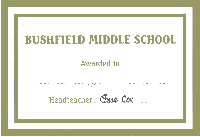In 1909 £5 of school funds was set aside for awarding as prizes.
1930s
Prizes were awarded to outstanding pupils at speech days which were held at the Church Institute (now Madcap). Girls were required to dress in white dress and stockings. The prizes awarded were mostly books donated by Governors. The Head Boy and Girl each had a wooden plaque ot the school crest after a year in office.
Prizes were also awarded for sporting prowess and the person with the most points over the year got to keep the cup for the year.
1950s-60s
Merit cards were used for good behaviour, as remembered by Peter Goodwin.
1980s
There was a change in culture in the school in 1980 when Mr Sudworth became Headmaster. He disbanded the houses as he did not agree with them and awards were no longer made to houses.
1990s
Reward systems are usually determined by the Head and Rosemary Kearsey operated a system called Privilege time. This was a half hour period on a Friday when various fun activities (e.g. quizzes, arts and crafts, board or card games, etc.) were on offer to pupils who could choose what they wanted to do. Deductions from this time were operated as a form of punishment.
1998 - 2001
Sue Cox, the Headmistress, introduced a system of reward in school with children receiving certificates for regular attendance. Merits were awarded by class teachers for good work, helping in class, improved behaviour and other achievements. They were recorded in Personal Organisers with stamps in a grid. Certificates are awarded in assembly and all individually signed and handed over by Mrs Cox with a handshake.
- 25 merits - interim certificate
- 50 merits - bronze certificate
- 75 merits - silver certificate
- 100 merit - gold certificate

